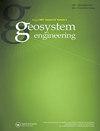Impact of air pollution on groundwater contamination through water reservoir
IF 1.1
Q3 GEOSCIENCES, MULTIDISCIPLINARY
引用次数: 0
Abstract
ABSTRACT In this article, an incisive analysis had been carried out to investigate the impact of air pollution on groundwater through a water reservoir. The primary objective of the present work was to develop a mathematical model that shows the direct impact of air pollution on groundwater contamination. The advection-dispersion equation (ADE) was considered to model the contaminant transport through the different media. Due to its inherent complexities, contaminant transport through the different domains was often difficult to model. To overcome it, the simple solution was to consider different velocities and dispersion for different domains. It was considered that the air zone was directly connected with the groundwater through a large water body. Initially, water body and aquifer had been considered contaminant free along with the flux type boundary condition at the semi-infinite part of the boundary. The model had been solved analytically using Laplace transformations. The current study demonstrates that depending upon the length of the medium the impact of contaminant would vary significantly. The air pollution source height had a direct impact on the contaminant concentration level in the aquifer aquitard system. The current study also illustrates that around 25% of air pollutants were induced in the groundwater.大气污染通过水库对地下水污染的影响
摘要本文深入分析了空气污染对水库地下水的影响。本工作的主要目的是建立一个数学模型,显示空气污染对地下水污染的直接影响。采用平流-色散方程(ADE)来模拟污染物在不同介质中的运移。由于其固有的复杂性,污染物通过不同领域的运输往往难以建模。为了克服这个问题,简单的解决方案是考虑不同域的不同速度和色散。认为空气区通过一个大的水体与地下水直接相连。最初,在边界的半无限部分采用通量型边界条件,认为水体和含水层不含污染物。利用拉普拉斯变换对模型进行了解析求解。目前的研究表明,根据介质的长度,污染物的影响会有很大的不同。空气污染源高度对含水层含水层系统中污染物浓度水平有直接影响。目前的研究还表明,大约25%的空气污染物是由地下水引起的。
本文章由计算机程序翻译,如有差异,请以英文原文为准。
求助全文
约1分钟内获得全文
求助全文

 求助内容:
求助内容: 应助结果提醒方式:
应助结果提醒方式:


